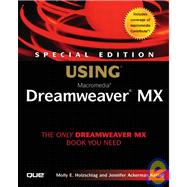
I. DESIGNING SITES WITH DREAMWEAVER.
1. Defining Your Site.II. WORKING MORE EFFICIENTLY IN DREAMWEAVER.
III. WRITING AND EDITING HTML, XHTML, AND CSS.
IV. PROFESSIONAL PAGE DESIGN.
V. DESIGNING FOR INTERACTIVITY.
VI. ADDING MULTIMEDIA.
VII. MANAGING YOUR SITE.
VIII. EXPANDING DREAMWEAVER AND USING THIRD-PARTY SOFTWARE.
IX. APPENDIXES.
The New copy of this book will include any supplemental materials advertised. Please check the title of the book to determine if it should include any access cards, study guides, lab manuals, CDs, etc.
The Used, Rental and eBook copies of this book are not guaranteed to include any supplemental materials. Typically, only the book itself is included. This is true even if the title states it includes any access cards, study guides, lab manuals, CDs, etc.